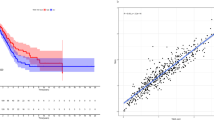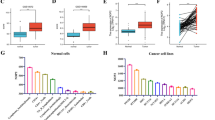Abstract
E2F activators (E2F1–3) codify a family of transcription factors (TFs) in higher eukaryotes. E2F activators are involved in the cell cycle regulation and synthesis of DNA in mammalian cells, and their overexpression has been detected in many human cancers. However, their clinical significance has not been deeply researched in non-small-cell lung cancer (NSCLC), and bioinformatics analysis has never been reported to explore their clinical role in NSCLC. In the current study, we investigated the expression and prognostic value of E2F activators in NSCLC patients through the “TCGA datasets” and the “Kaplan-Meier plotter” (KM plotter) database. Hazard ratio (HR), 95 % confidence intervals, and log-rank P were calculated. Compared with normal tissue samples, E2F activators were overexpressed in NSCLC tissues, in lung adenocarcinoma (LUAD) tissues, and in lung squamous cell carcinoma (LUSC) tissues. In NSCLC patients, E2F1 expression was significantly correlated with age, sex, and tumor stage. E2F2 expression was found to be significantly correlated with sex and tumor size. We further demonstrated that E2F1 and E2F2 overexpressions were significantly associated with poor prognosis. In LUAD patients, E2F1 expression was significantly correlated with tumor size and tumor stage. E2F2 expression was significantly correlated with lymph node status and tumor stage. E2F1 and E2F2 overexpression showed a significant association with poor prognosis, while E2F3 overexpression was significantly correlated to better prognosis. In LUSC patients, E2F1 was concluded to be significantly correlated with tumor stage. However, E2F activators were not found to be correlated to prognosis.




Similar content being viewed by others
References
Siegel RL, Miller KD, Jemal A. Cancer statistics, 2016. CA Cancer J Clin. 2016;66:7–30.
Ramalingam SS, Owonikoko TK, Khuri FR. Lung cancer: new biological insights and recent therapeutic advances. CA Cancer J Clin. 2011;61:91–112.
Subramaniam S, Thakur RK, Yadav VK, Nanda R, Chowdhury S, Agrawal A. Lung cancer biomarkers: state of the art. J Carcinog. 2013;12:3.
Cooper WA, Lam DC, O’Toole SA, Minna JD. Molecular biology of lung cancer. J Thorac Dis. 2013;5(Suppl 5):S479–90.
Niklinski J, Niklinska W, Laudanski J, Chyczewska E, Chyczewski L. Prognostic molecular markers in non-small cell lung cancer. Lung Cancer. 2001;34(Suppl 2):S53–8.
Gorgoulis VG, Zacharatos P, Mariatos G, Kotsinas A, Bouda M, Kletsas D, Asimacopoulos PJ, Agnantis N, Kittas C, Papavassiliou AG. Transcription factor E2F-1 acts as a growth-promoting factor and is associated with adverse prognosis in non-small cell lung carcinomas. J Pathol. 2002;198:142–56.
Abreu VA, Howard MS. Tumor-suppressor genes, cell cycle regulatory checkpoints, and the skin. N Am J Med Sci. 2015;7:176–88.
Attwooll C, Lazzerini DE, Helin K. The e2f family: specific functions and overlapping interests. EMBO J. 2004;23:4709–16.
Trimarchi JM, Lees JA. Sibling rivalry in the e2f family. Nat Rev Mol Cell Biol. 2002;3:11–20.
DeGregori J, Johnson DG. Distinct and overlapping roles for e2f family members in transcription, proliferation and apoptosis. CURR MOL MED. 2006;6:739–48.
Iaquinta PJ, Lees JA. Life and death decisions by the e2f transcription factors. Curr Opin Cell Biol. 2007;19:649–57.
Dimova DK, Dyson NJ. The e2f transcriptional network: old acquaintances with new faces. Oncogene. 2005;24:2810–26.
Li J, Ran C, Li E, Gordon F, Comstock G, Siddiqui H, Cleghorn W, Chen HZ, Kornacker K, Liu CG, Pandit SK, Khanizadeh M, Weinstein M, Leone G, de Bruin A. Synergistic function of e2f7 and e2f8 is essential for cell survival and embryonic development. Dev Cell. 2008;14:62–75.
Westendorp B, Mokry M, Groot KM, Holstege FC, Cuppen E, de Bruin A. E2f7 represses a network of oscillating cell cycle genes to control s-phase progression. Nucleic Acids Res. 2012;40:3511–23.
Nakayama KI, Nakayama K. Ubiquitin ligases: cell-cycle control and cancer. Nat Rev Cancer. 2006;6:369–81.
Peart MJ, Poyurovsky MV, Kass EM, Urist M, Verschuren EW, Summers MK, Jackson PK, Prives C. Apc/c(cdc20) targets e2f1 for degradation in prometaphase. Cell Cycle. 2010;9:3956–64.
Chen H, Tsai S, Leone G. Emerging roles of e2fs in cancer: an exit from cell cycle control. Nat Rev Cancer. 2009;9:785–97.
Wu L, Timmers C, Maiti B, Saavedra HI, Sang L, Chong GT, Nuckolls F, Giangrande P, Wright FA, Field SJ, Greenberg ME, Orkin S, Nevins JR, Robinson ML, Leone G. The e2f1-3 transcription factors are essential for cellular proliferation. Nature. 2001;414:457–62.
DeGregori J, Leone G, Miron A, Jakoi L, Nevins JR. Distinct roles for e2f proteins in cell growth control and apoptosis. Proc Natl Acad Sci U S A. 1997;94:7245–50.
Santos M, Martinez-Fernandez M, Duenas M, Garcia-Escudero R, Alfaya B, Villacampa F, Saiz-Ladera C, Costa C, Oteo M, Duarte J, Martinez V, Gomez-Rodriguez MJ, Martin ML, Fernandez M, Viatour P, Morcillo MA, Sage J, Castellano D, Rodriguez-Peralto JL, de la Rosa F, Paramio JM. In vivo disruption of an rb-e2f-ezh2 signaling loop causes bladder cancer. Cancer Res. 2014;74:6565–77.
Rennhack J, Andrechek E. Conserved e2f mediated metastasis in mouse models of breast cancer and her2 positive patients. Oncoscience. 2015;2:867–71.
Shackney SE, Chowdhury SA, Schwartz R. A novel subset of human tumors that simultaneously overexpress multiple e2f-responsive genes found in breast, ovarian, and prostate cancers. Cancer Inform. 2014;13:89–100.
Suzuki T, Yasui W, Yokozaki H, Naka K, Ishikawa T, Tahara E. Expression of the e2f family in human gastrointestinal carcinomas. Int J Cancer. 1999;81:535–8.
Huang CL, Liu D, Nakano J, Yokomise H, Ueno M, Kadota K, Wada H. E2f1 overexpression correlates with thymidylate synthase and survivin gene expressions and tumor proliferation in non small-cell lung cancer. Clin Cancer Res. 2007;13:6938–46.
Chen L, Yu JH, Lu ZH, Zhang W. E2f2 induction in related to cell proliferation and poor prognosis in non-small cell lung carcinoma. Int J Clin Exp Pathol. 2015;8:10545–54.
Cooper CS, Nicholson AG, Foster C, Dodson A, Edwards S, Fletcher A, Roe T, Clark J, Joshi A, Norman A, Feber A, Lin D, Gao Y, Shipley J, Cheng SJ. Nuclear overexpression of the e2f3 transcription factor in human lung cancer. Lung Cancer. 2006;54:155–62.
Tomczak K, Czerwinska P, Wiznerowicz M. The cancer genome atlas (tcga): an immeasurable source of knowledge. Contemp Oncol (Pozn). 2015;19:A68–77.
Guo Y, Sheng Q, Li J, Ye F, Samuels DC, Shyr Y. Large scale comparison of gene expression levels by microarrays and rnaseq using tcga data. PLoS One. 2013;8:e71462.
Muzny DM, Bainbridge MN, Chang K, Dinh HH, Drummond JA, Fowler G et al. Comprehensive molecular characterization of human colon and rectal cancer. Nature. 2012;487(7407):330–337.
Koboldt DC, Fulton RS, McLellan MD, Schmidt H, Kalicki-Veizer J, McMichael JF et al. Comprehensive molecular portraits of human breast tumours. Nature. 2012;490(7418):61–70.
Gyorffy B, Surowiak P, Budczies J, Lanczky A. Online survival analysis software to assess the prognostic value of biomarkers using transcriptomic data in non-small-cell lung cancer. PLoS One. 2013;8:e82241.
Gyorffy B, Lanczky A, Eklund AC, Denkert C, Budczies J, Li Q, Szallasi Z. An online survival analysis tool to rapidly assess the effect of 22,277 genes on breast cancer prognosis using microarray data of 1,809 patients. Breast Cancer Res Treat. 2010;123:725–31.
Gyorffy B, Lanczky A, Szallasi Z. Implementing an online tool for genome-wide validation of survival-associated biomarkers in ovarian-cancer using microarray data from 1287 patients. Endocr Relat Cancer. 2012;19:197–208.
Xu MM, Mao GX, Liu J, Li JC, Huang H, Liu YF, Liu JH. Low expression of the FoxO4 gene may contribute to the phenomenon of EMT in non-small cell lung cancer. Asian Pac J Cancer Prev. 2014;15:4013–8.
Hung JJ, Hsueh CT, Chen KH, Hsu WH, Wu YC. Clinical significance of E2F1 protein expression in non-small cell lung cancer. Exp Hematol Oncol. 2012;1:18.
Tai MC, Kajino T, Nakatochi M, Arima C, Shimada Y, Suzuki M, Miyoshi H, Yatabe Y, Yanagisawa K, Takahashi T. Mir-342-3p regulates MYC transcriptional activity via direct repression of E2F1 in human lung cancer. Carcinogenesis. 2015;36:1464–73.
Gu Y, Cheng Y, Song Y, Zhang Z, Deng M, Wang C, Zheng G, He Z. MicroRNA-493 suppresses tumor growth, invasion and metastasis of lung cancer by regulating E2F1. PLoS One. 2014;9:e102602.
Volm M, Koomagi R, Rittgen W. Clinical implications of cyclins, cyclin-dependent kinases, RB and E2F1 in squamous-cell lung carcinoma. Int J Cancer. 1998;79:294–9.
Ivey-Hoyle M, Conroy R, Huber HE, Goodhart PJ, Oliff A, Heimbrook DC. Cloning and characterization of E2F-2, a novel protein with the biochemical properties of transcription factor E2F. Mol Cell Biol. 1993;13:7802–12.
DeGregori J. The genetics of the E2F family of transcription factors: shared functions and unique roles. Biochim Biophys Acta. 2002;1602:131–50.
Reimer D, Sadr S, Wiedemair A, Goebel G, Concin N, Hofstetter G, Marth C, Zeimet AG. Expression of the E2F family of transcription factors and its clinical relevance in ovarian cancer. Ann N Y Acad Sci. 2006;1091:270–81.
Reimer D, Sadr S, Wiedemair A, Stadlmann S, Concin N, Hofstetter G, Muller-Holzner E, Marth C, Zeimet AG. Clinical relevance of E2F family members in ovarian cancer—an evaluation in a training set of 77 patients. Clin Cancer Res. 2007;13:144–51.
Zhan L, Huang C, Meng XM, Song Y, Wu XQ, Miu CG, Zhan XS, Li J. Promising roles of mammalian E2Fs in hepatocellular carcinoma. Cell Signal. 2014;26:1075–81.
He Y, Armanious MK, Thomas MJ, Cress WD. Identification of E2F-3B, an alternative form of E2f-3 lacking a conserved n-terminal region. Oncogene. 2000;19:3422–33.
Leone G, Nuckolls F, Ishida S, Adams M, Sears R, Jakoi L, Miron A, Nevins JR. Identification of a novel E2F3 product suggests a mechanism for determining specificity of repression by RB proteins. Mol Cell Biol. 2000;20:3626–32.
Adams MR, Sears R, Nuckolls F, Leone G, Nevins JR. Complex transcriptional regulatory mechanisms control expression of the E2F3 locus. Mol Cell Biol. 2000;20:3633–9.
Feber A, Clark J, Goodwin G, Dodson AR, Smith PH, Fletcher A, Edwards S, Flohr P, Falconer A, Roe T, Kovacs G, Dennis N, Fisher C, Wooster R, Huddart R, Foster CS, Cooper CS. Amplification and overexpression of E2F3 in human bladder cancer. Oncogene. 2004;23:1627–30.
Oeggerli M, Tomovska S, Schraml P, Calvano-Forte D, Schafroth S, Simon R, Gasser T, Mihatsch MJ, Sauter G. E2F3 amplification and overexpression is associated with invasive tumor growth and rapid tumor cell proliferation in urinary bladder cancer. Oncogene. 2004;23:5616–23.
Foster CS, Falconer A, Dodson AR, Norman AR, Dennis N, Fletcher A, Southgate C, Dowe A, Dearnaley D, Jhavar S, Eeles R, Feber A, Cooper CS. Transcription factor E2F3 overexpressed in prostate cancer independently predicts clinical outcome. Oncogene. 2004;23:5871–9.
Author information
Authors and Affiliations
Corresponding author
Rights and permissions
About this article
Cite this article
Gao, Z., Shi, R., Yuan, K. et al. Expression and prognostic value of E2F activators in NSCLC and subtypes: a research based on bioinformatics analysis. Tumor Biol. 37, 14979–14987 (2016). https://doi.org/10.1007/s13277-016-5389-z
Received:
Accepted:
Published:
Issue Date:
DOI: https://doi.org/10.1007/s13277-016-5389-z




